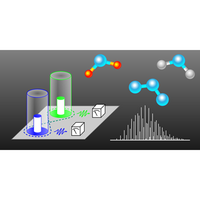当前位置:
X-MOL 学术
›
Phys. Rev. X
›
论文详情
Our official English website, www.x-mol.net, welcomes your
feedback! (Note: you will need to create a separate account there.)
Efficient Multiphoton Sampling of Molecular Vibronic Spectra on a Superconducting Bosonic Processor
Physical Review X ( IF 11.6 ) Pub Date : 2020-06-17 , DOI: 10.1103/physrevx.10.021060 Christopher S. Wang , Jacob C. Curtis , Brian J. Lester , Yaxing Zhang , Yvonne Y. Gao , Jessica Freeze , Victor S. Batista , Patrick H. Vaccaro , Isaac L. Chuang , Luigi Frunzio , Liang Jiang , S. M. Girvin , Robert J. Schoelkopf
Physical Review X ( IF 11.6 ) Pub Date : 2020-06-17 , DOI: 10.1103/physrevx.10.021060 Christopher S. Wang , Jacob C. Curtis , Brian J. Lester , Yaxing Zhang , Yvonne Y. Gao , Jessica Freeze , Victor S. Batista , Patrick H. Vaccaro , Isaac L. Chuang , Luigi Frunzio , Liang Jiang , S. M. Girvin , Robert J. Schoelkopf

|
The efficient simulation of quantum systems is a primary motivating factor for developing controllable quantum machines. For addressing systems with underlying bosonic structure, it is advantageous to utilize a naturally bosonic platform. Optical photons passing through linear networks may be configured to perform quantum simulation tasks, but the efficient preparation and detection of multiphoton quantum states of light in linear optical systems are challenging. Here, we experimentally implement a boson sampling protocol for simulating molecular vibronic spectra [J. Huh et al., Nat. Photonics 9, 615 (2015)] in a two-mode superconducting device. In addition to enacting the requisite set of Gaussian operations across both modes, we fulfill the scalability requirement by demonstrating, for the first time in any platform, a high-fidelity single-shot photon number resolving detection scheme capable of resolving up to 15 photons per mode. Furthermore, we exercise the capability of synthesizing non-Gaussian input states to simulate spectra of molecular ensembles in vibrational excited states. We show the reprogrammability of our implementation by extracting the spectra of photoelectron processes in , , , and . The capabilities highlighted in this work establish the superconducting architecture as a promising platform for bosonic simulations, and by combining them with tools such as Kerr interactions and engineered dissipation, enable the simulation of a wider class of bosonic systems.
中文翻译:

在超导Bosonic处理器上对分子振动光谱进行高效的多光子采样
量子系统的有效仿真是开发可控量子机器的主要动力。对于寻址具有潜在的玻色结构的系统,利用自然的玻色平台是有利的。穿过线性网络的光学光子可以配置为执行量子模拟任务,但是在线性光学系统中有效准备和检测光的多光子量子态具有挑战性。在这里,我们通过实验实现了玻色子采样协议,以模拟分子振动光谱[J. Huh等。,Nat。光子学 9,615(2015)]在双模超导装置中。除了在两种模式下制定必要的高斯运算集外,我们还通过在任何平台上首次演示一种高保真单发光子数解析检测方案来满足可扩展性要求,该方案能够解析每个光子最多15个光子。模式。此外,我们行使合成非高斯输入态的能力,以模拟振动激发态下的分子集成体的光谱。我们通过提取中的光电子过程的光谱来展示实现的可重编程性, , 和 。这项工作中强调的功能将超导体系结构确立为玻色模拟的一个有前途的平台,并且通过将它们与诸如Kerr相互作用和工程耗散的工具相结合,可以模拟更广泛的玻色系统。
更新日期:2020-06-17
中文翻译:

在超导Bosonic处理器上对分子振动光谱进行高效的多光子采样
量子系统的有效仿真是开发可控量子机器的主要动力。对于寻址具有潜在的玻色结构的系统,利用自然的玻色平台是有利的。穿过线性网络的光学光子可以配置为执行量子模拟任务,但是在线性光学系统中有效准备和检测光的多光子量子态具有挑战性。在这里,我们通过实验实现了玻色子采样协议,以模拟分子振动光谱[J. Huh等。,Nat。光子学 9,615(2015)]在双模超导装置中。除了在两种模式下制定必要的高斯运算集外,我们还通过在任何平台上首次演示一种高保真单发光子数解析检测方案来满足可扩展性要求,该方案能够解析每个光子最多15个光子。模式。此外,我们行使合成非高斯输入态的能力,以模拟振动激发态下的分子集成体的光谱。我们通过提取中的光电子过程的光谱来展示实现的可重编程性, , 和 。这项工作中强调的功能将超导体系结构确立为玻色模拟的一个有前途的平台,并且通过将它们与诸如Kerr相互作用和工程耗散的工具相结合,可以模拟更广泛的玻色系统。











































 京公网安备 11010802027423号
京公网安备 11010802027423号